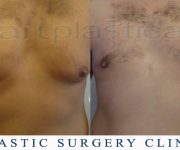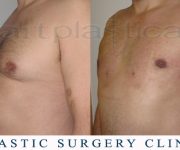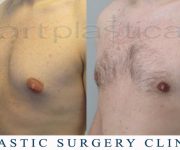GYNECOMASTIA – male breast hypertrophy due to glandular, fibrous or adipose tissue growth – can occur regardless of age.
GYNECOMASTIA CAUSES:
- Hormonal changes (lack of balance between testosterone and estrogen). If these changes affect teenagers, the problem usually disappears at the end of puberty. Ailments can also occur along with the aging process – men produce less testosterone, which normally counteracts undesirable influence of estrogen.
- Overweight and obesity. It can cause cumulation of body fat in the breast area. Obesity also increases the level of estrogen, which stimulates the enlargement of the breast gland.
- Side effect of taking certain medications
The problem can cause mental discomfort and negatively affect self-esteem by limiting daily physical activity.
Gynecomastia can be located on one side or on both sides and is characterized by:
- Excess amount of fat in the breast area
- Excessively enlarged glandular tissue
- Saggy and loose breast skin
GYNECOMASTIA OPERATION STEP BY STEP:
Gynecomastia surgery involves reducing the male breasts and improving the shape of the chest. In some cases, excessive breast tissue can cause soreness and stretching of the areola (dark skin around the nipple). In such cases, the position and size of the breast can be surgically corrected. For patient comfort, this procedure is performed under general anesthesia.
If the problem is excessive amount of fat, the solution is liposuction of the breast. The small cannula that is used during the surgery leaves hardly noticeable mark on the skin or a very small scar (point).
If the problem of gynecomastia is caused by excessively developed breast tissue, then excision techniques should be performed. This is an operation that includes a surgical incision that usually leaves the scar around the breast. In case of a large reduction, the scar may go beyond the areola.
Most often the problem of gynecomastia is complex and requires both reduction of the breast tissue and liposuction of excessive fat.
RESULT OF OPERATION
The effect of gynecomastia surgery is visible almost immediately after the surgery. Over time, the healing process progresses: bruises disappear usually after one week, and postoperative swelling is present up to 4-6 weeks.
The final result of the treatment is visible after 3-6 months. Post-surgical scars fade, becoming less visible. Almost every method of gynecomastia involves making incisions on the skin. Most scars are hidden in the natural contours of the body, making them imperceptible. Some, however, have to go beyond the natural folds of the breast to achieve the best possible result.
PLEASE NOTE: Surgical practices are not exact science. Despite the expectations of good results, there is never a guarantee. In some cases, achieving the best outcome may not be possible with only one operation. Sometimes another small correction may be required to achieve the desired aesthetic goal.
POST-OPERATIVE PROCEDURES
Recommendations for patients who underwent gynecomastia surgery at the Beauty Group Artplastica Clinic in Szczecin:
- After surgery, you will receive a well-fitted compression gourmet to continuously wearing for several consecutive weeks.
- On the day of discharge, you will also receive written post-operative recommendations with all relevant information needed during the recovery period.
- During the first 2-3 weeks after surgery, avoid physical activity.
- During the first six weeks after surgery, avoid heavy physical activity like lifting or sport (aerobics, gym, swimming, etc.).
- Up to 6 months after surgery avoid sauna, solarium tanning and intensive sunbathing.












